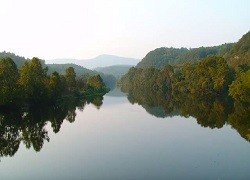This lesson is for : Grade 6:
Summary
Students will collaborate to assemble and synthesize data about activities in our watershed that can ultimately impact waterways as far away as the Chesapeake Bay. They will then work in groups, using digital tools, to communicate the impact of these human activities by creating a public service announcement. The PSAs will be shown to people in the community in an effort to raise awareness for maintaining clean waterways.
TIPC Ratings
Research & Information Fluency
Rating: Ideal – Explanation: Students analyzed maps of our locality to research our watershed, and completed a field investigation, in order to generate authentic questions about human activities in our watershed that can impact our waterways. Each class generated several survey questions that were then assembled into one large google form survey. The students then administered the survey to people in our community , using those questions, to collect data on the prevalence of the problems identified. Each science teacher did this with 2 classes and then shared the data (responses from the google sheet) with the other teacher so the students then had 4 surveys and all the data points (responses) collected from each class. The students, in groups, then synthesized this information to help them identify a particular impact the local community has on the watershed. The students, in groups, then completed further online research using their research logs in order to develop a basis for their PSA.
Communication & Collaboration
Rating: Ideal – Explanation: The project began with using online discussion boards (Schoology) where students communicated prior knowledge and understanding about watersheds. Students also communicated with students in other classes taught by other teachers to develop the initial human activities survey questions. The survey that the several classes came up with was the one used to poll participants in our local community (at home). The students then took all responses gathered from all classes for their research. Students also had access to questions and responses of another science teacher’s classes survey points. In addition, they communicated and collaborated using Google Docs for their research log to synthesize their watershed research. One student shared a current news article with the class which the teacher then uploaded to an online platform (Schoology and the other teacher used Google Drive) and then had students comment on the news article. This allowed students to reflect and see other classmates comments. In addition, students worked with an expert in Soil and Water conservation to complete field investigations. Once finished, they reflected on their collaborative experience on a Google form. The students then viewed other PSAs (through a Schoology Media Album or class shared google folder) to then take back to survey participants to share awareness.
Critical Thinking & Problem Solving
Rating: Approaching – Explanation: This project focused on a real world problem about how the local community impacts the local watershed and ultimately our waterways. Students used discussion boards, google forms, and google documents to collaborate ideas and help identify impacts. Students generated purposeful questions in the survey questions and in their own research logs to guide their research and PSA creation. Using spreadsheets and summary of result pie charts allowed students to synthesize survey data points. They thought critically about watershed problems they identified in order to develop a PSA that is authentic and meaningful to the citizens of Glen Allen, Virginia.
Creativity & Innovation
Rating: Approaching – Explanation: Students analyzed data and trends about watershed activities in our area and generated their PSA product to address the issues they identified. Their original works were shared in order to provide meaningful solutions to existing problems. Students reflected on their work and their learning.





